Summer Flowers
Photocollage by Reina Lopez
Ready to publish, previously unused
Photocollage by Reina Lopez
Reader beware! The author has no formal credentials in the fields of psychology, physiology, or life management, but decades of personal experience with confusion, indecisiveness, procrastination and wide-ranging dysfunction have convinced him that he is qualified to experiment and advise on those subjects. Use at your own risk!
Do you ever feel like your brain consists of a multitude of gerbils, all running at top speed on their exercise wheels with no net progress whatsoever? I do, and after protracted research and reflection I have come to understand why, and what to do about it. And I am going to share that with you.
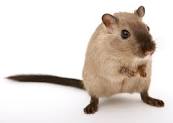
calm but alert gerbil
The secret: If it acts like a gerbil, treat it like a gerbil! Unfortunately, the rodent model of human cognition has received far too little popular attention. Herewith, a brief description to facilitate effective interactions.
First, forget about the scientific jargon involving neurons, synapses, etc. Your nervous system is a nation of teeny tiny gerbils, organized into interconnected communities according to their occupational specialties. When the system is well-supported and operating smoothly, it produces a high GEP (Gerbil Economic Product) for export to you.
There are Collector Gerbils who receive and import resources from the Outside (e.g, sounds, sights, smells, etc.) and transform them into what we can think of as kibble. A wide range of kibble of different shapes, sizes, colors, tastes, and digestibility. These they pass on to the Sorter Gerbils.
Sorters have limited autonomy; they can pass certain kinds of kibble directly to the appropriate specialists, but mostly they are guided by the decisions of a committee of Silverback Gerbils, who oversee the distribution of inputs in order to maintain the GEP.

Team Gerbil, ready for project
Usually things work smoothly, but sometimes the input causes the Collectors to produce an imbalance of kibble types, including too much poorly digestible kibble that takes a long time to process. Then the Sorters are passing too many bits to the Emergency Response Gerbils, and becoming frustrated by the overload and unbalanced inventory.
The Silverbacks, faced with multiple unaccustomed problems, fall to arguing among themselves and fail to instruct the sorters. As a result, the communities receive a downpour of poorly sorted kibble that overwhelms their infrastructure and does not provide the necessary resources. The communities of Producer Gerbils fragment within, and try to raid other communities for the necessary resources. Order breaks down, and GAF (Gerbil Adrenaline Flow) spikes – sometimes dangerously. This condition is known as Non-Selective Overload (NSO).
What then? Every gerbil has access to an exercise wheel, individual or communal. Under normal conditions an appropriate amount
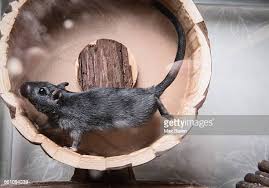
Stressed gerbil working out
of well-timed exercise keeps the individual and community functioning. When overload builds up, the gerbils instinctively try to burn up their GAF by exercising harder and longer on the wheel, sometimes skipping work to do so. Productivity goes down.
When full-blown NSO is occurring, the gerbils become almost demonically hyperactive; they leap on their wheels and dash frenziedly “forward” in a glazed-eye, mouth-foaming sprint. Both gerbils and wheels squeak and chatter loudly, and of course GEP plummets. You can’t help but notice this – often acutely.

Ultimate Overload
Dealing with NSO – the solution to the problem of getting your gerbils back to work is, somewhat counterintuitively, a different kind of overload. Ultra-Selective Overload (USO) is a technique for replacing the distractingly diverse and unbalanced input of NSO with a surfeit of a very few kinds of attractive and enjoyable input. The gerbils are made happy by what they get, realize that production is impossible, and subside into mellow passivity. GEP remains very low, but it is essential to recognize this as a necessary period of recovery that will result in a quicker return to normal behavior.
Providing Ultra-Selective Overload: Control of the material that the Collector Gerbils can access is one of the most effective means of getting to USO. One possibility is total shutdown – essentially, starving the communities into submission. Unfortunately, the starting point almost always involves large existing stocks of poorly digestible kibble that keep the communities operating poorly and unhappily.

Recovering gerbil
So — and here comes the advice – we need to pick out a few Collectors and feed them input that will produce lots of kibble with pleasantly hypnotic qualities. It has to be sustainable; the gerbils do not calm down and get off their wheels immediately — they need to be coaxed into resting mode over time. Taste, smell and touch are hard to sustain; sight and sound are the obvious choices for kibble raw material in our era of technologically augmented input.
HOW TO: Let’s acknowledge that natural may be best – although peripheral inputs may distract, real-world floating clouds, fluttering leaves, and flowing water can do the job. But that means you have to find a desirable environment where you can hang out any time, and more or less indefinitely. Realistically, you may need to soothe your gerbils at night, or in bad weather, or in the middle of a city. Then —

Completely soothed gerbils
We use our smart TV, computer, or maybe cell phone (but screen and speakers are pretty small). Some of the things that my gerbils respond to can be seen or downloaded by clicking on https://thecomplement.info/wp-content/uploads/2023/06/Soothing-methods.pdf. Yours may be different, but there are many sources offering various alternatives. For simplicity, my examples are accessible on Youtube, which can be accessed free from any computer/phone browser with an internet connection, and from most if not all smart TVs.
So check them out. Get a feeling for what might work before the furry little rascals slide all the way into anarchy. Once you have taken the initial steps into gerbil control, you will find that you are better positioned to start adjusting the community diet as soon as the first few wheels start squeaking. Remember, if you look after your Inner Gerbils, they will look after you.
By George Yates

Figure 1: The wild horses are aware of our presence but are mostly habituated to humans. [ghy]
The history of wild horses on the North American continent is replete with all the drama to be expected from any topic involving conflicting cultural, economic, and political interests. There is ongoing debate if the horses are indigenous or invasive; if they are wild or feral; indeed, if they should be completely eradicated. The good news is that the wild horses are currently protected by both federal and state laws.
Wild horses are defined by federal law as unbranded, unclaimed, free-roaming horses found on public lands in the United States. Today, the Bureau of Land Management (BLM) protects and manages wild horses in balance with other public resource values on 177 herd management areas across 26.9 million acres of public lands. The phrase ‘in balance with other public resource values’ in the previous sentence exposes the basic, to date, unresolved conflicts between wild horse advocates and ranching interests, among others. The BLM is in the midst of this political tug-of-war charged with the nearly impossible task of finding a universally accepted mustang management policy.
Spanish settlers likely first brought horses to the Americas in 1519, when Hernán Cortés arrived on the continent in Mexico. At this time, North America was widely covered with open grasslands, serving as a great habitat for these horses. The horses quickly adapted and spread across the nation. Around 1550, the first known feral horses escaped Mexico City, and more followed over time. Native Americans began to capture and ride the horses, spreading them further across the continent. The oral histories from Indigenous groups tell of interactions with horses prior to colonizers arriving in their homelands.
Although it has been over five centuries since the Spanish Mustangs return to North America, they are technically a non-native species and therefore the wild horse population is not indigenous. This is also true of cattle, sheep, and goats; however, desert bighorn sheep and mountain goats are indigenous.
So, in 2023 given the conflicting cultural, economic, and political interests there are heated debates involving the Bureau of Land Management (BLM), state and local governments, farmers, ranchers, land developers, and wild horse advocates involving the best use of the land and the control of the wild horse herds. Personally, I just like observing wildlife and taking their pictures.
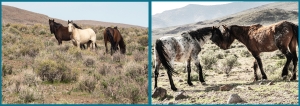
Figure 2: The left panel shows behavior I try to avoid photographing – a horse grazing, which is what they mostly do. The two watching me photograph them quickly lost interest when they determined that I was not a threat. The right panel shows greeting behavior. [ghy]
The history of the Wild Horses of the Virginia Range dates back to the 1800s. Over time, some of these horses were released or escaped from their owners and established wild herds. The Virginia Range Wild Horses are descendants of these horses.
In 1955, Reno resident Velma Johnston, better known as “Wild Horse Annie”, led a movement to protest the ruthless manner in which wild horses were being rounded up by the Nevada Department of Wildlife for commercial purposes. She lobbied state legislatures to stop rounding up Nevada’s wild horses on state land to sell to pet food manufacturers. Her movement led to the passing of the “Wild Horse Annie Act” in 1959. Today, these majestic animals are known as “Annie’s Horses”. In 1971 the federal government followed suit, further protecting these wild animals with the creation of the Wild Horse and Burro Protection Act of 1971, which provided legal protection to the Virginia Range herd.
Despite the legal protection and public support, these horses still face many challenges. One of the main concerns is the rapid population growth, which can lead to overgrazing and damage to the range. Another is the risks of collisions between the horses and vehicles on the roads that run through the range.
To mitigate these risks, several management strategies have been implemented, including controlling the population through fertility control and roundups, reducing the risk of vehicle collisions by installing fencing, and working with the residents to educate them about the importance of protecting the Wild Horses.
When in an unfamiliar area with limited time it is advisable to hire a local guide. Hiring a guide serves two purposes; they know where the horses are, and you save the wear and tear on your own vehicle. We hired Marty Wright to show us around in our quest to view and photograph the wild horses.

Figure 3: Tour Guide: Marty Wright – Wild Horses Carry Me Away.
Marty Wright (281) 546-4680 mustangmarty@icloud.com. [ghy]
We drove into a development and spotted a band of around a dozen horses meandering toward a house, so we ventured onto private property to observe their behavior. The homeowner came out to greet us and turned out to be very welcoming. Frank told me that he and his wife had lived here for about 25 years and really enjoyed the wild horses.
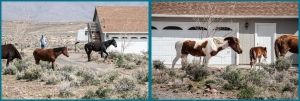
Figure 4: A small band of mustangs meandering in front of a home, completely ignoring the humans observing them. [ghy]
The behavior of wild horses at water troughs is fascinating and I have observed it on at least two other occasions. There was already a band lined up to drink from the trough, each horse patiently waiting its turn. The band we were following simply queued up at the end of the line.

Figure 5: Left panel – on the way to water. Right pane – waiting a turn. [ghy]
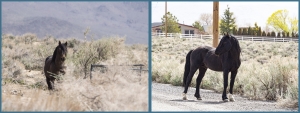
Figure 6: Left panel – exiled until he forms his own band. Right panel – stay away. [ghy]

Figure 7: The stallion drops, rolls, and prepares to stand. [ghy]

Figure 8: The stallion stands, shakes off the sand, and gallops across the field. [ghy]
Driving along the USA Parkway you get a sense of future development; hills are being leveled, mile after mile of active construction equipment building roads, and preparing additional infrastructure.

Figure 9: Tesla GigaFactory1 [Mar 2022]. The site is energy independent, with wind farm, solar, and geothermal sources. If fully built out, the building will have the largest footprint in the world. This factory will also manufacture a fully electric truck, Semi. [Internet image, Joshua Froschauer]
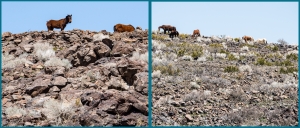
Figure 10: Horses grazing along a ridge line at Centennial Park. [ghy]

Figure 11: The fight lasted less than two minutes with much snorting and whinnying. [ghy]
The Wild Horses of the Virginia Range have a long and rich history, and they attract visitors from all over the world. They are a beautiful sight, and are thought of, by many, as a symbol of American heritage. Driving home, our final view of the mustangs was of a large group quietly grazing along the shore of Washoe Lake.
For additional information: The Wild Horse Preservation League and the Virginia Range Wildlife Protection Association are volunteer non-profit organizations dedicated to keeping Nevada’s mustangs and burros wild and free. For more information about them, visit https://greatnonprofits.org/org/wild-horse-preservation-league or https://vrwpa.com/.
Everybody has opinions about language. If the following material does not render you glassy-eyed and drooling, you will have an opportunity tell us yours.
Our Chief Word Nerd ran away to Hawaii this month and may not be back in the harness by deadline time – so it falls to me to provide you with TMNPLI = Too Much Nit-Picking Linguistic Information, this time about Neologisms. Definition (found by Google):
“A neologism is a newly created word or expression that is not part of our official language system. Neologisms are also existing words or phrases that have gained a new meaning. Some Common Neologisms are App, Webinar, Staycation, Wicked, Sick, Google, Spam, Noob, BFF, Floss, Social Gifting, Chillax and Frinally.”
The examples given are various forms, including abbreviations or acronyms (App, BFF)1, and redefined real words (wicked, sick, floss). The invented words can be broken into categories: (a) Combined words that have a semi-obvious literal meaning – Webinar, Staycation; (b) Words that sound and are spelled like real words – Google (think goo, ogle, giggle, gaggle), Spam (we already have spar, spat, span), maybe Frinally; (c) Pronounceable formulations that resemble nothing much else in English (Noob, Chillax2).
There is another category that deserves our attention – English word stems that have been restructured for convenience or to conform to some (other) grammatical or linguistic model. These tend to enrage purists and engage utilitarians.
Prime example: ORIENTATE, which is back-derived from ORIENTATION, which is a legitimate offspring of ORIENT (v.t., align or direct).
What’s wrong with the original more concise verb, “orient”? The only thing I can think of is that if you capitalize it you get a noun that designates a geographic region, but I doubt that the process of orienting a person would be mistaken for sending Him/Her/Them/It to Asia, or for turning HHTI (another instant neologism) into an Asian. After all, we don’t invent another word for polish just because there is a country containing Poles.
Words ending in “-ation” seem particularly vulnerable, probably because we have many verbs ending in “-ate,” for which the standard designation of process or product is “-ation” (graduate, hesitate, decapitate). However, there is a smaller but substantial number of simpler (not ending in “-ate”) verbs in which “-ation” is used as a suffix for the same purposes. Adding two syllables and then removing one to get to the original meaning complicates and expands the language in the assumed service of consistency.
I propose a seemingly radical but more efficient way to standardize orthography — the Orient Rule, which forms the verb by removal of “-ation” (and associated conjunctive letters). This may oblige us to oper on some of the other “-ate,” or even “-tion” words
I specule that if we formuly constructive neologisms in this fashion, it may necess adding a terminal “-e” or “-y” as well as I will design this as a topic to explic in a subsequent column. To elabor, the Rule will help us avoid complicing the language without violing the natural tendency to fix on standards.
Since English is a complied language, reducing words to their least common denominer will mean that teachers can educe students without debbing about their tendency to be preoccuped with consistency.
A fully coordined adoption of the Rule will inevitably oblige us to elimine a few existing verb forms. For instance, “r,” “st,” and “equ” are somewhat problematic to apply as English stems for which to crey verbs Non-native speakers may be confused by some “-ation” words that have no corresponding verb. Not only is “n” an inappropry verb, but “nating” would probably be most accurly transeled as “buttocking” (the more colloquial “butting” is something done primarily by ungules).
Despite the fact that some will hesit to adopt the recommend, I strongly advoce it. To demonster its utility, I want to indice the recent useful derivative of a “-tion” word. The Russia-Ukraine confront has led to much discussion of “attrition” which slid into English from Latin without a relled verb. “Attrit” (also “attritt,” but not “attrite”) has been widely adopted, and is a compact verb with an apprily blunt pronuncy.3
If you made it this far your literary juices should be at least up to a simmer, so go to the Reply section and enter your most loved or hated (h’ed?) neologisms (specify which) — either words alone or usage in a sentence. Or even those that you just don’t understand. The Editorial Board will award prizes for particularly insightful selections.
Footnotes (how else would you know this is a serious exposition?)
1Personal opinion: I think that a neologism should be a pronounceable word, and not just a collection of characters. What is bff supposed to sound like? (Don’t think too hard about this.)
2Right, there is a Hyrax, but the name comes from ancient Greek, and if you look up Hydrax you find that it is some sort of video villain (suitably alien). Relax is already a verb.
3Entries linking to attrit
early 15c., attricioun, “a breaking;” 1540s, “abrasion, scraping, the rubbing of one thing against another,” from Latin attritionem (nominative attritio), literally “a rubbing against,” noun of action from past-participle stem of atterere “to wear, rub away,” figuratively “to destroy, waste,” from assimilated form of ad “to” (see ad-) + terere “to rub” (from PIE root *tere- (1) “to rub, turn”).
The earliest sense in English is from Scholastic theology (late 14c.): “sorrow for sin merely out of fear of punishment or a sense of shame,” an imperfect condition, less than contrition or repentance. The sense of “wearing down of military strength” is from World War I (1914). Figurative use of that is by 1930.
Part 1:Taking Flight, or RVM’s Green Runway
It was not a dark and stormy night but darkening twilight, warm and with a clear sky when I was walking back to the Plaza after the fine performance of Hula O Nuku Aina when I noticed several turkeys in the Manor driveway heading toward the “South Forty.” It was nearly dark so they were most likely heading for some trees on which to spend the night. I detoured to the upper South Forty walkway to watch the turkeys fly into the trees.
One turkey was on its chosen branch on nearby oak tree, just some 15 feet up on an oak tree next to the sidewalk. He looked around nervously, no doubt wondering if he was high enough to avoid Stan and his minions. (Not knowing the ferocious Dave has taken over.) This turkey most be the outcast that I have noticed the rest of the flock will chase away.
The other turkeys were at the top of the steeply sloping lawn. Suddenly one sprinted down hill; its long thick legs a blur of speed and its neck stretched far forward; then with a running jump and unfolding of its wings, it was airborne. Strong strokes of its mighty wings propelled it up and up to finally hit near the top of a featherily-limbed conifer about 100 feet high. It hit at speed and branches flew up and down and crossways and then the bird disappeared as the branches closed about it. More experience turkeys aim for more open and top branches.
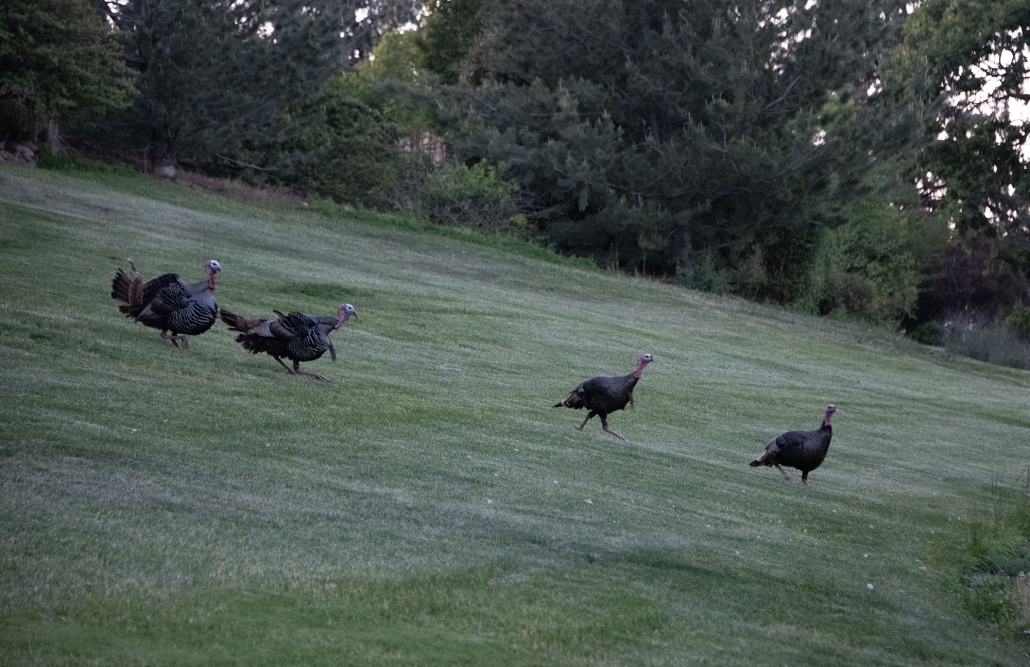
Wait, we need to organize and take turns.
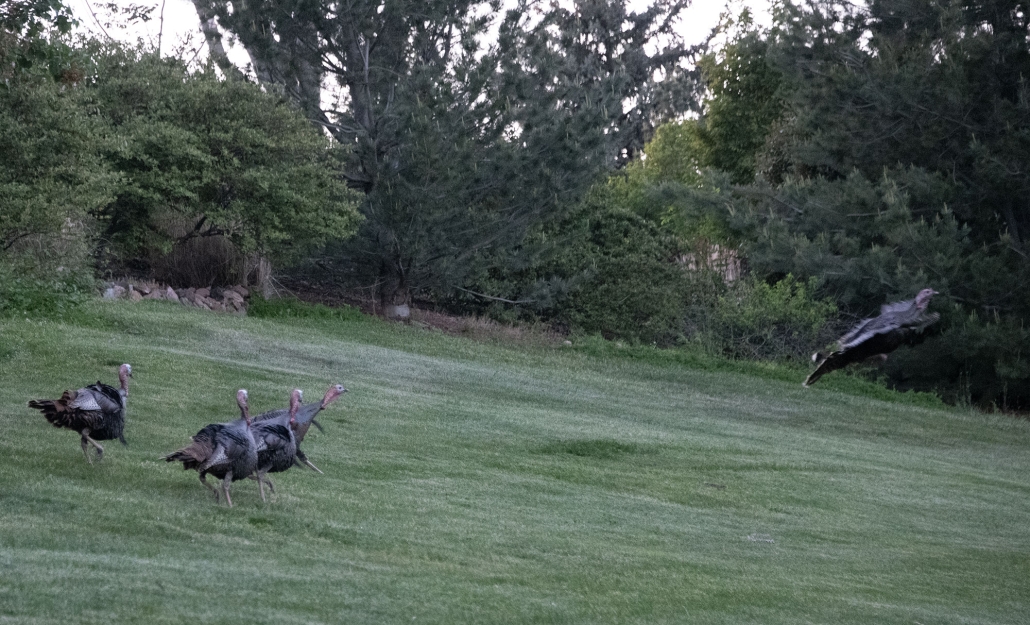
I’m not. waiting. Torie Stevens taught me how to do short take-offs.
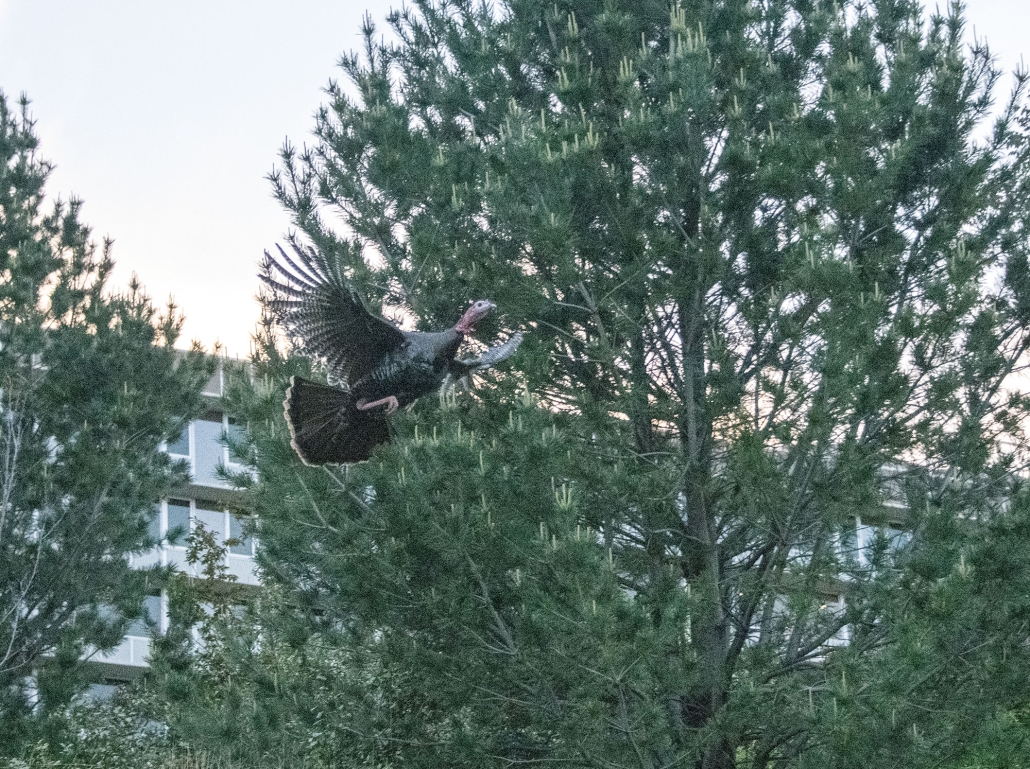
I can do short take-off from the top of the hill.
Meanwhile at the top of the lawn another turkey started its downhill sprint. It leaped into the air and arrowed toward the same tree but on the other side of the trunk. Again, whap, bang, pow, it plowed into the branches and disappeared. A third turkey, after watching the first two, took its turn: speeding downhill it rose far up into the air, landing on the very top of the same tree. Its weight bent down the top and the bird triumphantly stood there gently bopping up and down as it surveyed its surroundings. Two more turkeys were still wandering the top of the lawn but, having enough excitement for the night, I went home.
Later, Hannelore Herbig told me she has watched the show. It starts with the Alpha Tom gathering the flock and leading it to the South Forty. Most of the turkey gather at the top of the lawn and wait for the leader to fly up to the chosen tree first.
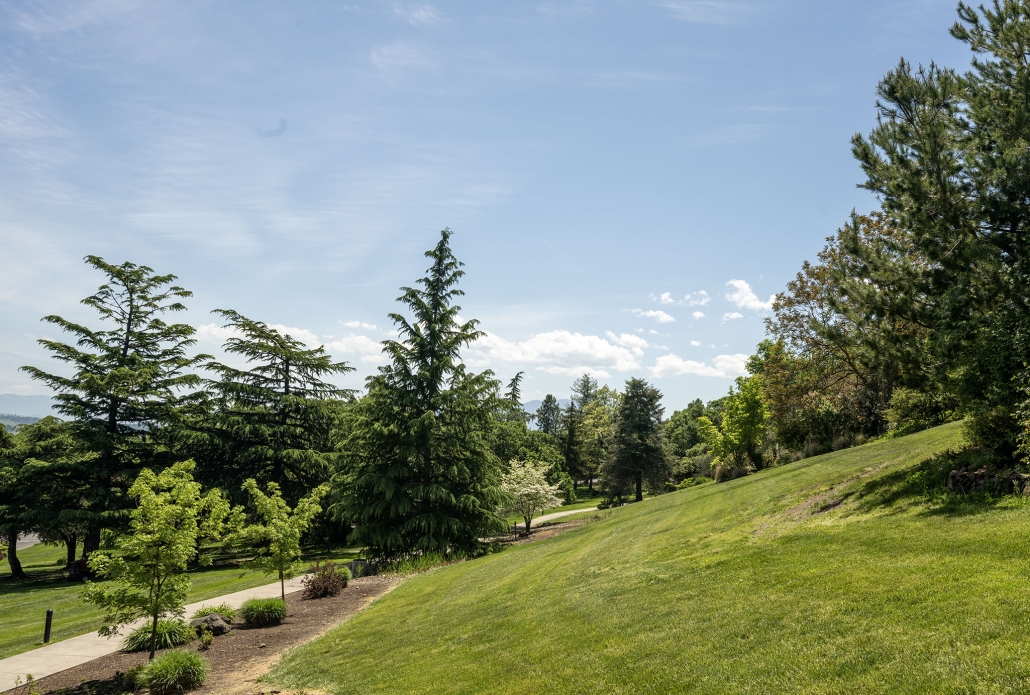
The Green Runway with the target trees on the left.
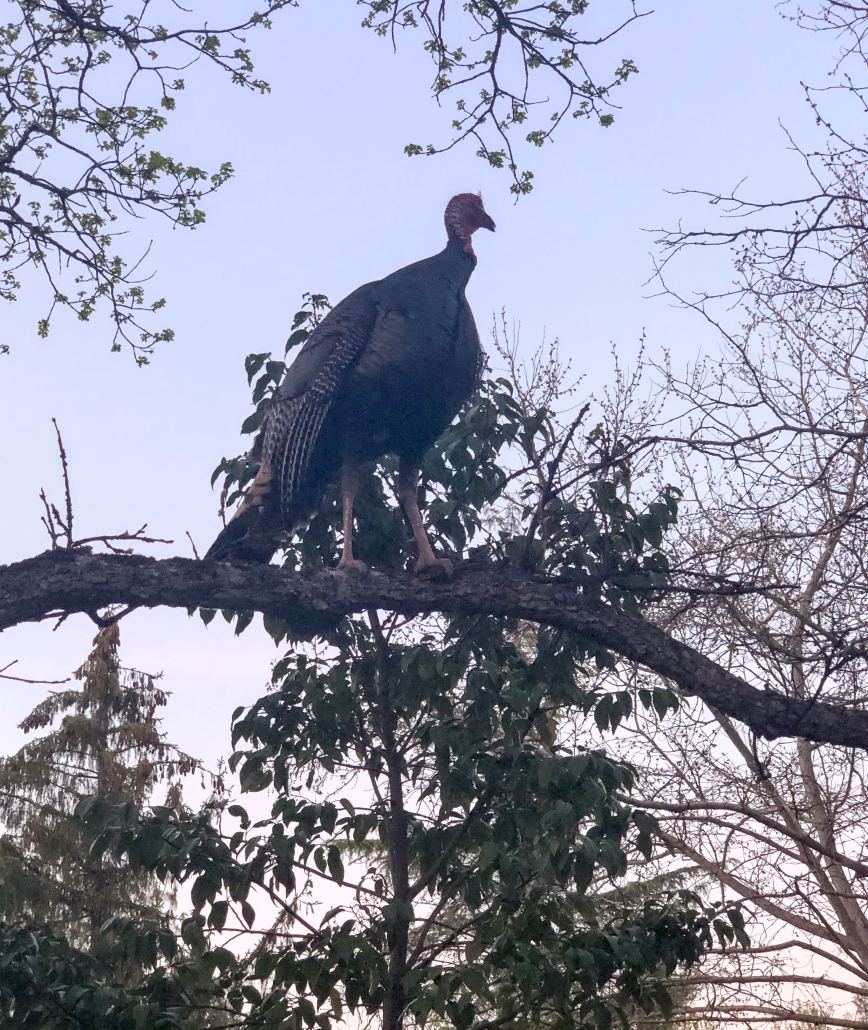
The outcast.
Part II: Too Many Turkeys on a Few Thin Branches?
I returned, a little late, to the Turkey show some days later. A half dozen turkeys were already in one of the conifers. They crowded the upper branches, two or more trying to perch on the same swaying branch. There was a. slight breeze but still some of the big birds had balance problems. They extended their tails, just a tight rope walkers use umbrellas; other had to use tail and wings and even then some birds were forced. to flutter to another branch.
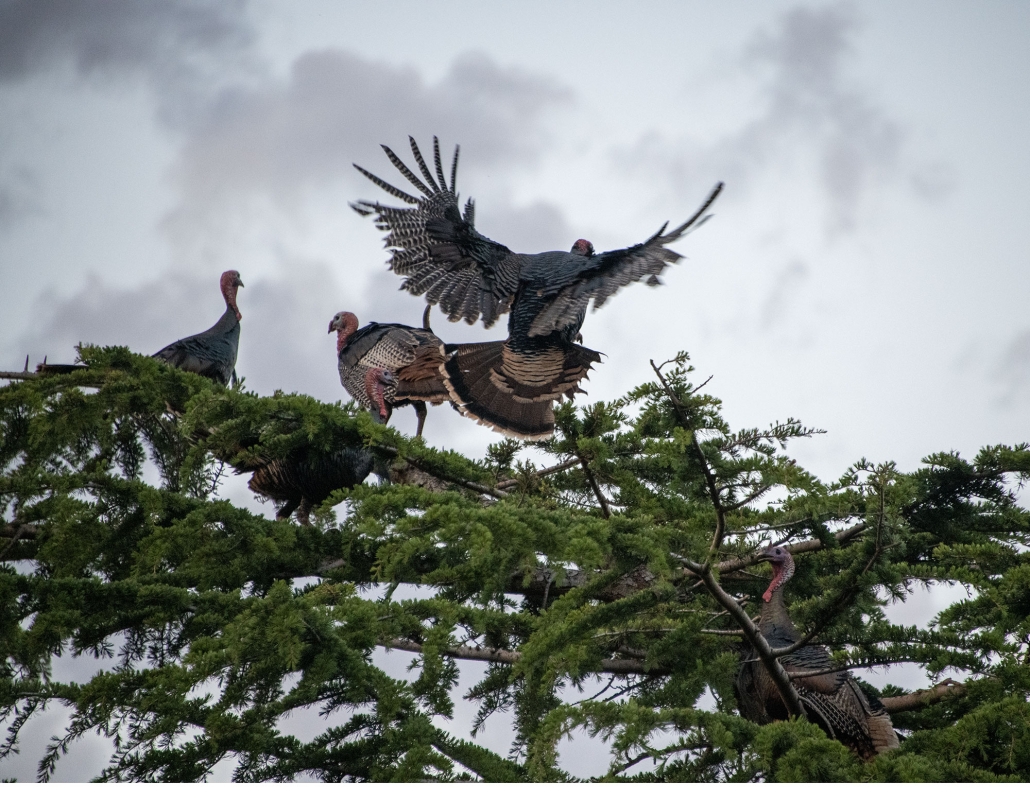
Joining the flock.
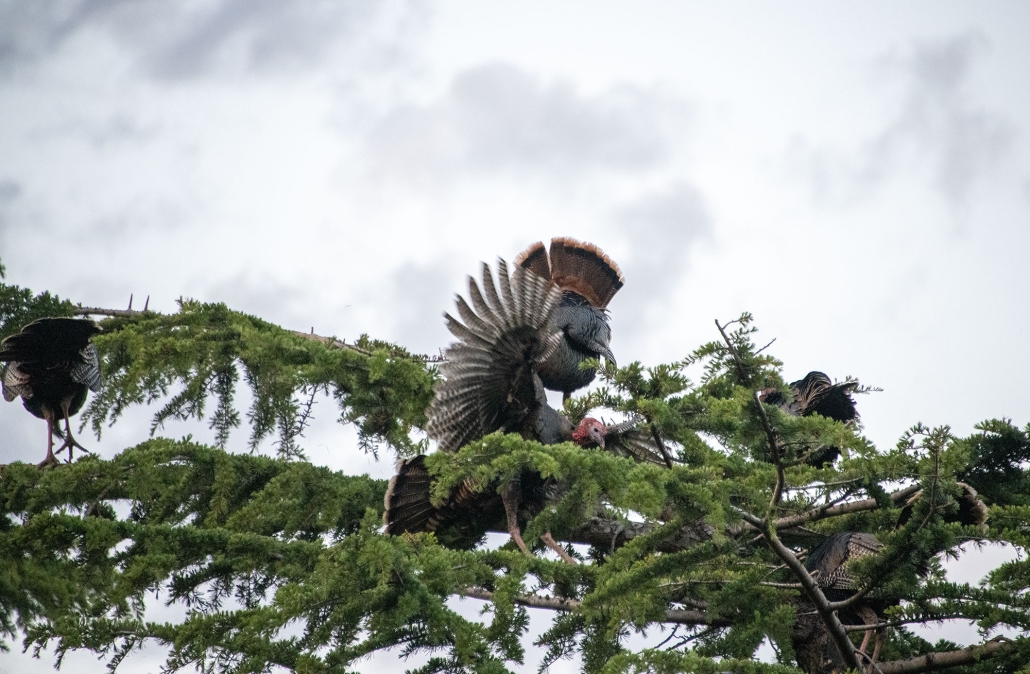
Tricky landing causing balance problems.
Another landing.
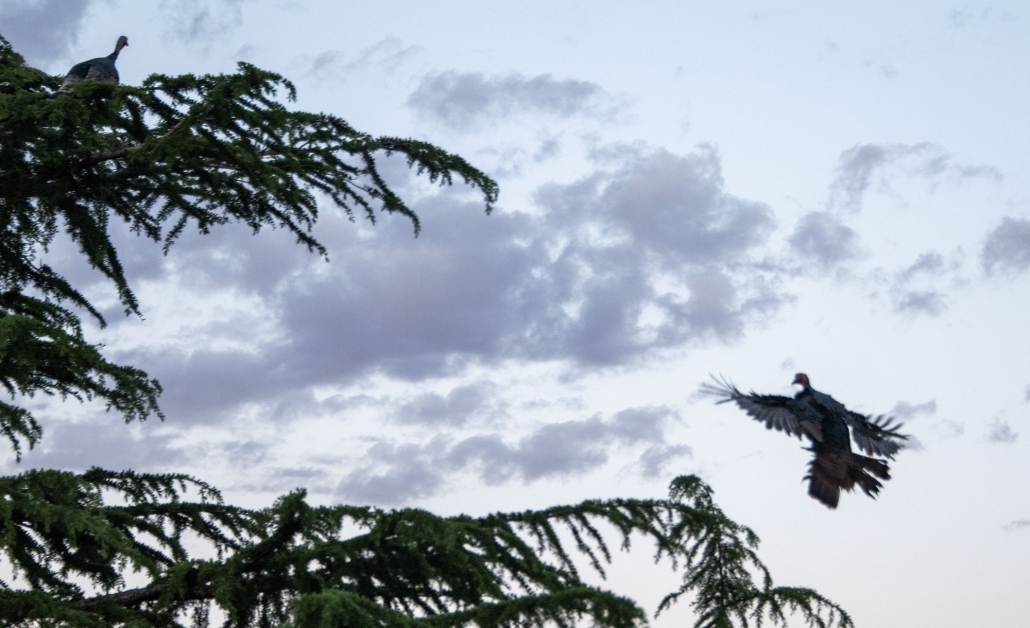
Landing apprroah
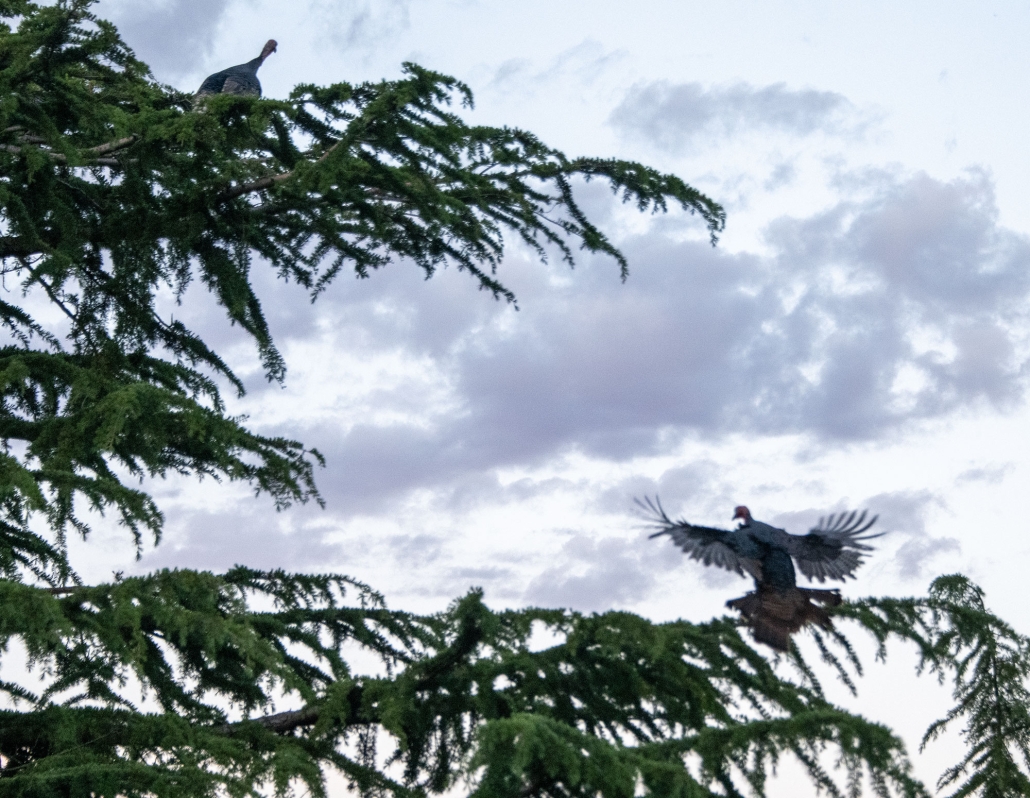
Almost there
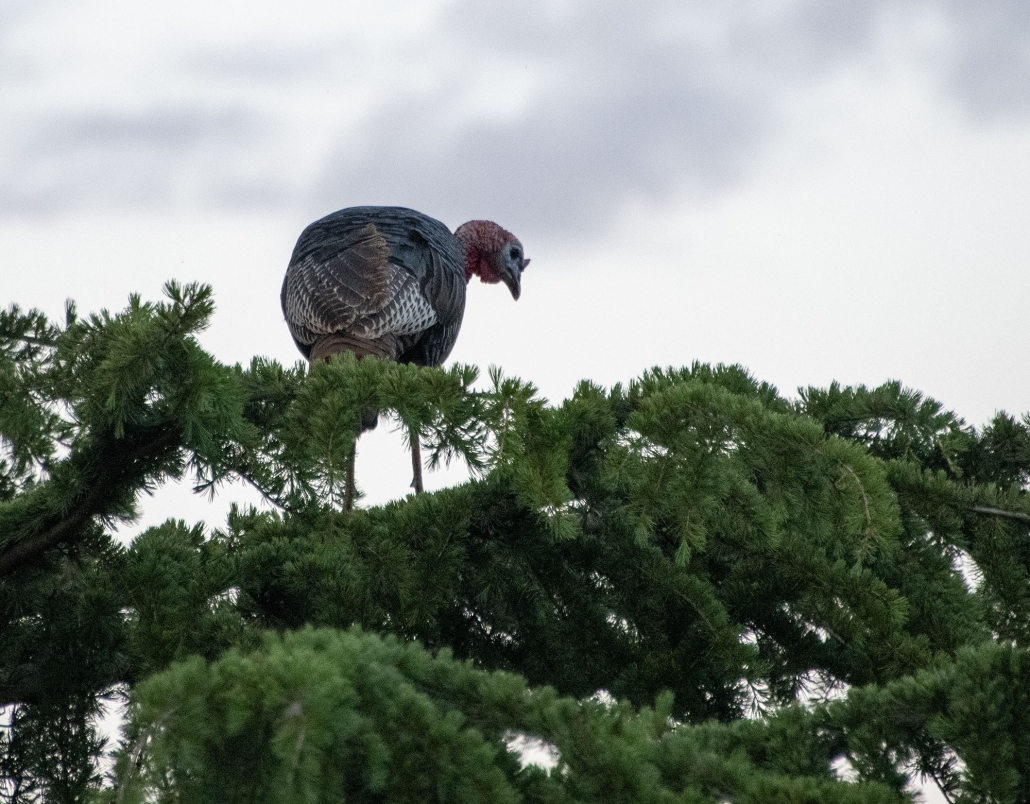
Success
When you try to get close to your buddies.
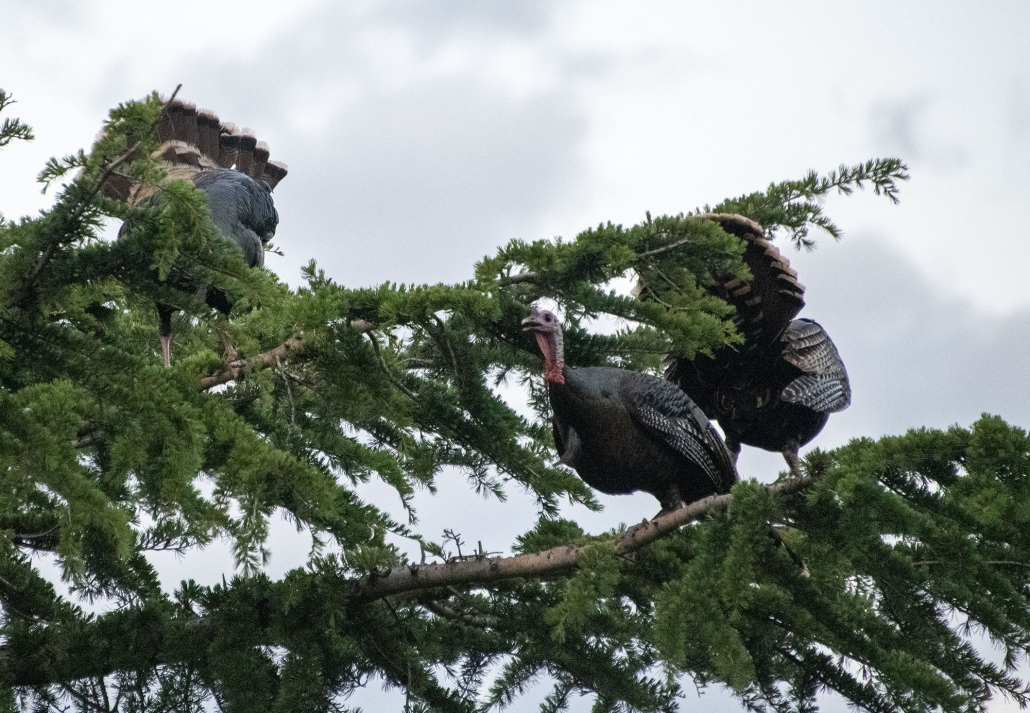
Watch it! You smashed his tail feathers!
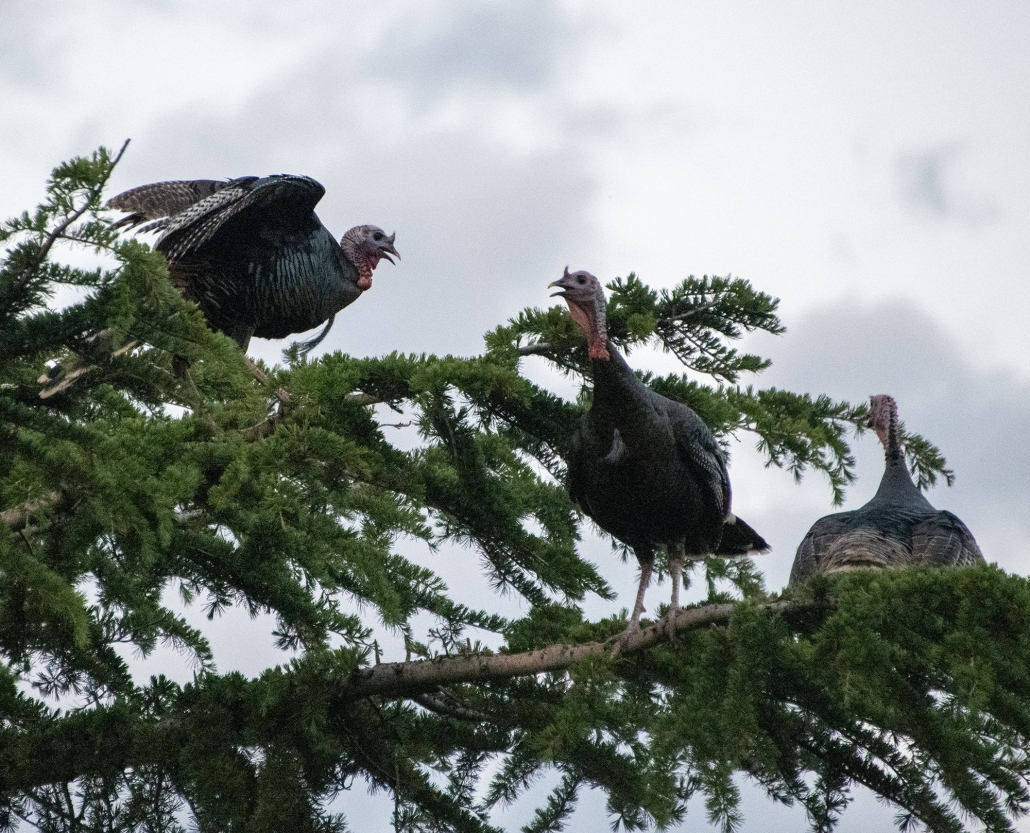
Settle down.
Don’t tell me what to do.
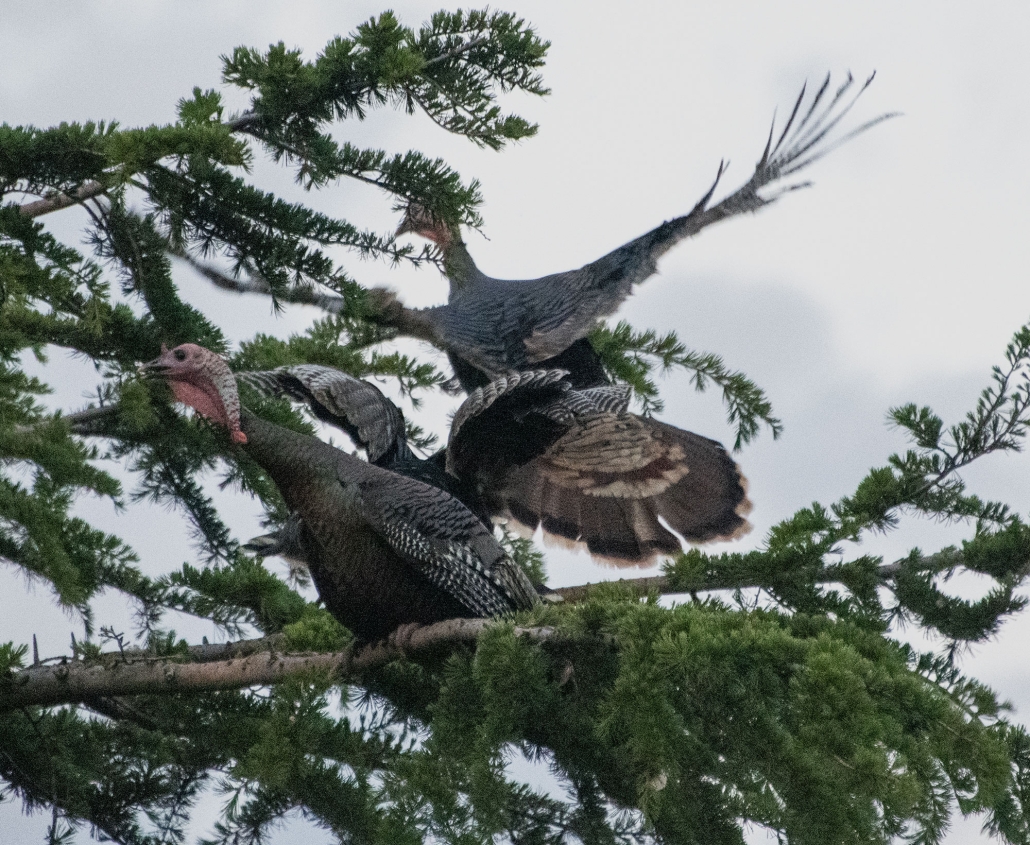
What are you doing!
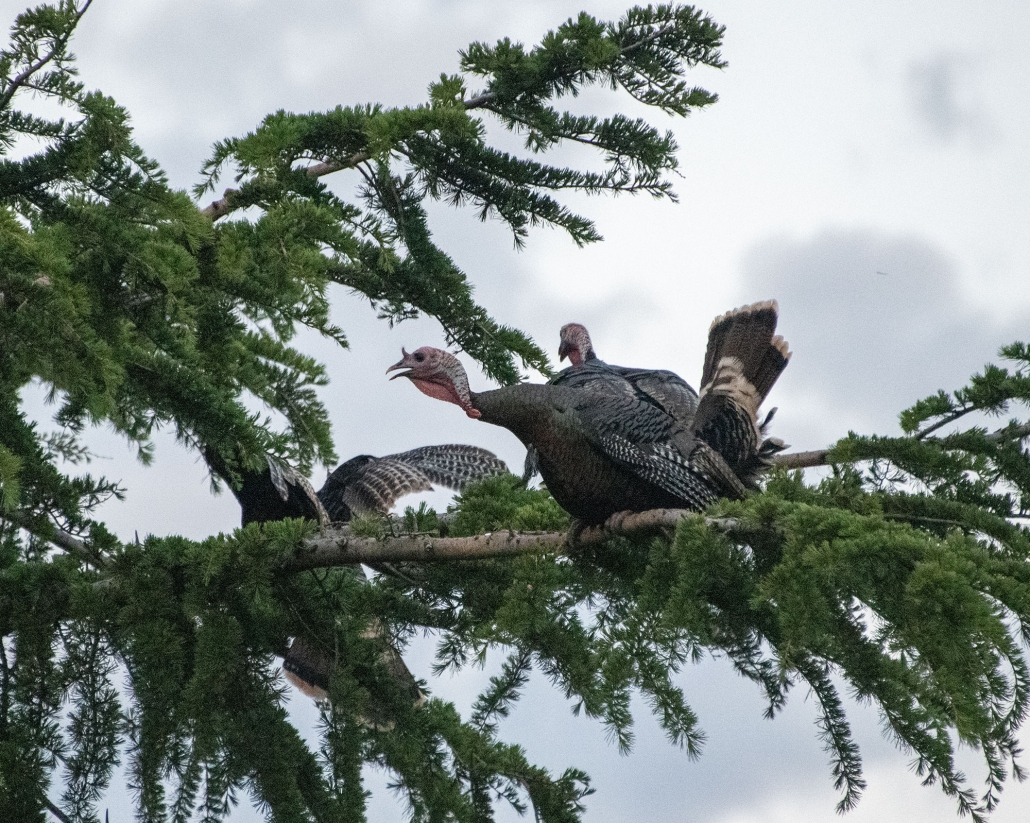
Stay put, you idiot.
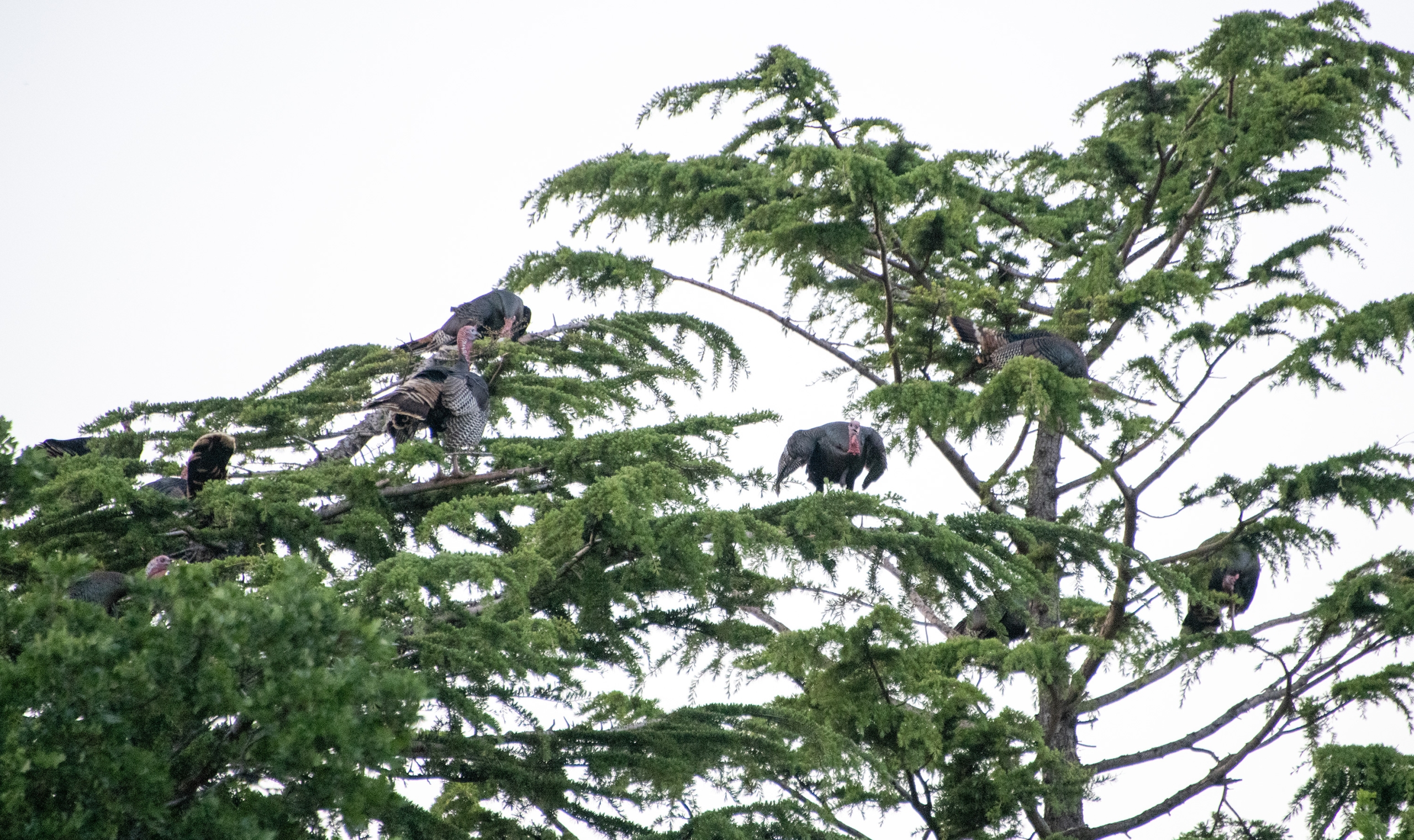
How many turkeys do you see?
Wright, Robert. The Evolution of God. Little, Brown, 2009.
 Wright’s thesis is that the concept of the Abrahamic God – the God of the God of Jews, the God of Christians and the God of Muslims – has evolved along with civilization. He says, “Gods speak through their followers, so when prevailing interpretations of a god change, the very character of the god changes.” In this well researched tome (over 560 pages, including an extensive bibliography), he looks at scriptures related to the Abrahamic god through the lens of history: when they were written and the circumstances surrounding their creation. God’s character is a product of the way Muslims, Christians and Jews think of Him. To put it succinctly, from the perspective of our times, cultural evolution is what has given us modern corporations, modern government, and modern religion.
Wright’s thesis is that the concept of the Abrahamic God – the God of the God of Jews, the God of Christians and the God of Muslims – has evolved along with civilization. He says, “Gods speak through their followers, so when prevailing interpretations of a god change, the very character of the god changes.” In this well researched tome (over 560 pages, including an extensive bibliography), he looks at scriptures related to the Abrahamic god through the lens of history: when they were written and the circumstances surrounding their creation. God’s character is a product of the way Muslims, Christians and Jews think of Him. To put it succinctly, from the perspective of our times, cultural evolution is what has given us modern corporations, modern government, and modern religion.
In studying Abrahamic scriptures, Wright finds that, contrary to the belief that Moses brought monotheism to the Middle East, ancient Israel (the home of Judaism and Christianity) was in fact polytheistic until after the Babylonian exile (5th century BCE). He finds evidence in parts of the Bible, for example, “that aren’t much read by modern believers,” of not only polytheism but of belief in the mediation of shamans among early leaders like Israel’s first king, Saul, who consulted a medium to raise the prophet Samuel from the grave for policy input (I Samuel 28:3-15).
Wright examines the multiple gods of hunter-gatherers and later of chiefdoms and ancient city-states, pointing to their beliefs as being displaced not all at once, but over time, off and on, a process more evolutionary than revolutionary. In texts of the three major Abrahamic religions, the belief in multiple gods evolved through the polytheism of ancient Israel, to monolatry and finally to monotheism, featuring at times a belligerent and intolerant god (based on a need to punish infidels); a tolerant god (based on the need for peaceful co-existence, as in the books of Ruth and Jonah); and, eventually, belief in a single omnipotent god.
But the single god wasn’t always a god of love. Wright claims that Jesus didn’t say, “Love your enemies” or extol the Good Samaritan. These misquotes were inserted in scripture decades after the Crucifixion. Muhammad was neither a militant religious zealot nor a benign spiritual leader but a cool political pragmatist.
Wright sees the “growth” of the Abrahamic god as an indicator of the growth of the moral order underlying history: as the scope of a social organization grows from hunter-gatherers to modern civilization, God tends to eventually catch up, despite Christian holy wars and Islamic jihad, drawing a larger expanse of humanity under his protection or at least a larger expanse of humanity under his toleration. But the movement toward moral truth has been globally modest, at best.
Wright argues that “Today globalization has made the planet too small to peacefully accommodate large religions that are at odds. If the Abrahamic god doesn’t foster tolerance, then we’re all in trouble” (205). Again, late in the book: “Maybe it’s not too much to say that the salvation of the planet – the coherence and robustness of an emerging global social organization – depends on [moral progress] . . . . once everybody is in the same boat, either they learn how to get along, or very bad things happen. . . . If the Abrahamic religions don’t respond to this ultimatum adaptively, if they don’t expand their moral imaginations, there is a chance of chaos on an unprecedented scale” (427).
Wright’s afterword is titled, “By the Way, What is God?” providing a provocative discussion of our difficulty conceptualizing what is beyond our comprehension. His appendix is titled, “How Human Nature Gave Birth to Religion,” another fascinating discussion. All in all, this book provides interesting food for thought. It’s a heavy book, in its size and in its concepts.
Wikipedia lists Wright as a journalist and author who writes about science, history, politics, and religion. He has written five books. As of 2019, he is a Visiting Professor of Science and Religion at Union Theological Seminary, New York.
by Bob Buddemeier
Those of us who frequent RVMlist have many opportunities to view compilations of “old stuff” — some nostalgic, many humorous, but mostly with a theme of “people nowadays don’t understand what it was like back in the day.” Telephones, toaster ovens, TVs (or lack thereof) and the ever-present ’57 Chevy. Some of the archaic icons I can relate to, some I can’t — my first car was a ’47 Nash. Major irony — the kid who couldn’t get a serious date had a car in which the back seat made into a bed.
It may be that my tendency toward being culturally crosswise inspired me (so to speak) to consider the subject backward – that is, in terms of the things that modem people take for granted that have passed me by. Or for which I have pulled over to allow them to go around, which is more often the case.
However, every so often I get curious enough about what I have missed to try to find out a little about what is going on out there in the world, and why. I get most of my news from newspapers, but not whole newspapers —individual articles deflected into Google News. I think — and hope — that this provides a lopsided view of things. If so, it could explain why, several years ago, I began to wonder who these Kardashians were, and what they did. After a little on-line research, I ultimately discovered that what they did was pose for photographs and engage in dysfunctional relationships, which is considered newsworthy in some circles.
 Which led me initially to the concept of the synthetic celebrity, on the basis of the idea that a celebrity is something to be celebrated. That would make “synthetic celebrity” an oxymoron, but on further reflection I decided that it was actually a redundancy. In modem American English, it seems to me that “celebrity” is rarely applied to anyone who has much of any redeeming social virtue or utility. Can you imagine calling Dr. Fauci a celebrity? Martin Luther King, Jr.?
Which led me initially to the concept of the synthetic celebrity, on the basis of the idea that a celebrity is something to be celebrated. That would make “synthetic celebrity” an oxymoron, but on further reflection I decided that it was actually a redundancy. In modem American English, it seems to me that “celebrity” is rarely applied to anyone who has much of any redeeming social virtue or utility. Can you imagine calling Dr. Fauci a celebrity? Martin Luther King, Jr.?
So it is with the Kardashians — manufactured plastic fame, coated with synthetic sweeteners. The eagerly awaited further adventures of Khaki, Komi, and Krum and their consorts-of-the-moment provide us with little more than a regrettable excuse to look down on the already-beleagured people of Armenian ancestry. [Contest above left: guess the Kardashian]
My latest — and ongoing — cultural research activity is, if I do say so myself, a trifle more high minded. What, I asked myself, are these “memes” that everybody refers to? I got the general idea that they are some sort of upscale emoticon that people are supposed to recognize as a surrogate for a complex concept.
On investigation, I found that their present popularity, somewhat like that of the Kardashians, is intimately linked to the internet. It all started out with Richard Dawkins (if you don’t know who he was, read on anyway — he’s not a real celebrity; that would be an oxymoron). He invented the term as a cultural analog of “gene” — the basic unit by which culture is transmitted from one (cultural) generation to the next.
I’m OK with that, but as I delved a little deeper, I ran into some conceptual problems. For example, it turns out that the picture of the girl staring at her boyfriend as he stares at another girl’s butt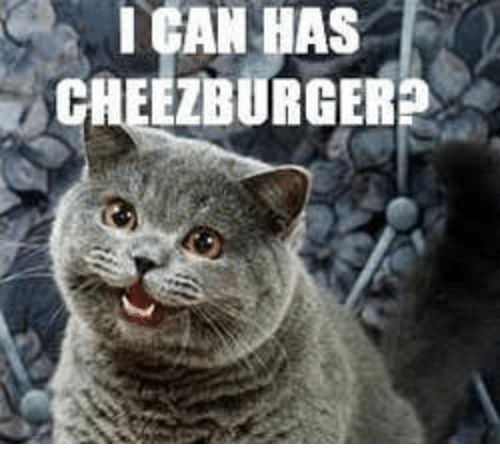 is a meme.
is a meme.
So are the LOLCATS (example at right). And Sign Bunnies. And Poe’s Law (“it is nearly impossible to tell the difference between satire of extremism and actual extremism on the internet”).
Dawkins predicted that cultural evolution would be incredibly fast compared to biological evolution because of the speed with which internet-accelerated memes could move, mix, and mutate. IMHO, with a strong emphasis on the mutation.
When asked about recent usage, Dawkins said “So when anybody talks about something going viral on the internet, that is exactly what a meme is and it looks as though the word has been appropriated for a subset of that.”
Well, fellow fogies, are you still with me? If so, start slowing down, because I’m pulling over to the side of the road again. Probably for good, this time.
[Wondering if I just made this up? Check out:
https://www.sciencefriday.com/articles/the-origin-of-the-word-meme/]